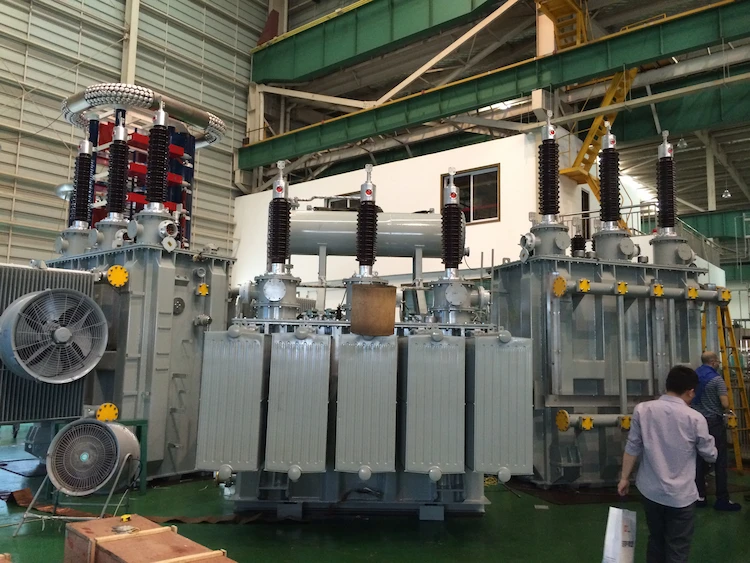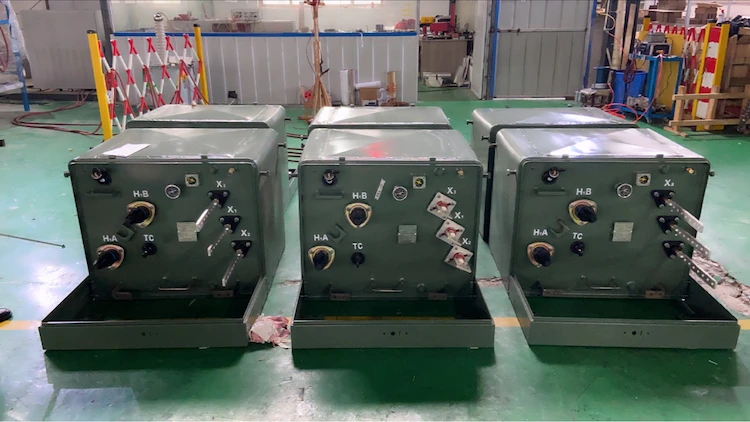
How to Choose Pad Mounted Transformer?
Table of Contents Selecting the right pad-mounted transformer requires careful consideration of several critical
ELECTRIC, WITH AN EDGE

The superiority of 20 kV Medium voltage level compared to 10 kV voltage level is analyzed, the different grounding methods of neutral point of 20 kv to volts level distribution are introduced, and the application of 20 kV voltage level in equipment selection, transformation and distribution is expounded. Room layout.
The 20 Kilovolts to Volts class has many advantages over the 10 Kilovolts to Volts class:
(1) Increase the power supply capacity.
The power supply capacity of a 10 kV single-circuit line generally does not exceed 8 000 k VA, while the power supply capacity of a 20 kV single-circuit dedicated line can reach 20 000 k VA.
The 20kv voltage level power supply provides twice as much power as the 10 kV voltage level, which is particularly effective for super high-rise buildings or communication network equipment rooms with high load density.
(2) Expand the power supply radius and reduce the number of power supply substations. Correspondingly reduce the amount of land use and save a lot of social costs.
Under the same load density, the power supply radius of 20 Kilovolts to Volts class is 1.26 times that of 10 kV voltage class, and the power supply area is 1.6 times that of 10 kV voltage class.
(3)Save non-ferrous metals and reduce line loss rate. At the same load level, the power loss of the 20kV Medium Voltage class is only 1/4 of that of the 10 kV voltage class.
The 20 kV voltage class will be used more and more.
This paper analyzes and discusses the problems that need to be paid attention to in the design of 20 kV client substations.
20 Kilovolts to Volts level neutral point grounding methods are mainly divided into three types:
Similar to the existing 10 kV.
This grounding method has good power supply continuity, but the maximum power frequency overvoltage generated when single-phase grounding is about 3.5 times the maximum phase voltage, which requires high insulation level of equipment.
20 Kilovolts to Volts level neutral point grounding methods are mainly divided into three types:
This grounding method can effectively reduce the power frequency overvoltage of the single-phase grounding fault, and the maximum power frequency overvoltage is 2.5 times the maximum phase voltage.
However, this power supply method increases the number of trips and blackout time of the line, and will generate a large fault current, resulting in a large step voltage, which poses a safety threat to the surrounding people and equipment.

The neutral point arc suppression ring grounding system compensates the capacitor current, the grounding current of the single-phase fault is small, and it can allow the line to continue to operate for a period of time when the single-phase fault occurs.
When a single-phase fault occurs, the maximum power frequency overvoltage is 3.2 times the maximum phase voltage.
Neutral low-resistance grounding systems are suitable for systems with capacitive currents greater than 150 A for cable laying methods.
The neutral point arc suppression ring grounding system is suitable for systems with a capacitance current of 10 to 150 A.
Ungrounded neutral systems are suitable for systems with capacitive currents less than 10 A.
The latter two grounding systems are more overhead.
The new 20 kv to volts system generally adopts the neutral point arc suppression ring grounding or low resistance grounding method.
When the 10 kV power distribution circuit is raised to 20 kV, the system capacitance current should be re-estimated, and the neutral grounding method should be selected according to the size of the capacitance current and the network conditions, that is to say, three grounding methods are possible.
The selection of the neutral point operation mode of the distribution network involves many factors such as the system overvoltage level, the equipment insulation level, the selection of overvoltage protection components, the sensitivity of relay protection, and the safety and reliability of system operation.
For building electrical designers, before designing a system, it is necessary to fully communicate with the power supply department and understand the neutral grounding method of its high-voltage system.

20kv voltage level transformers are divided into oil-immersed transformers and dry-type transformers.
The wiring group of the 20kV Medium Voltage transformer winding is generally Dyn11 or Yyn0.
The primary voltage of the distribution transformer is ±5% or ±2. 5%.
For oil-immersed transformers, choose short-circuit impedance as 5. 5% or 6%, choose 6% short-circuit impedance for dry-type transformers.
The insulation level of the 20kV transformer is shown in Table 1.
20 Kilovolts to Voltslevel switchgear is numerous, including high-voltage switchgear, circuit breakers, high-voltage disconnectors, fuses, etc.
The short-circuit capacity of the substation is related to the selection of switchgear.
In principle, the short-circuit capacity of the 20 kv to volts bus is controlled at 20 k A and below.
Therefore, the short-circuit capacity of the equipment can be selected as 25 k A, except for special high-capacity systems.

Accessories include arresters, voltage transformers, current transformers, etc.
The transformation ratio and accuracy level of the current 20kV Medium Voltage transformer are shown in the scope of supply table. The zero-sequence current transformer adopts the hoop type fast saturation type.
The rated capacity of the 20kV Medium Voltage transformer: 0.2 class 30 VA, 0.5 class 50 VA, 3P class 100 VA, should be equipped with harmonic elimination device.
Under the measuring voltage of 1.2 Um/3 kV, the partial discharge of the
20kV Medium Voltager and the current transformer shall not be greater than 10 p C, and a test report shall be provided.
The insulation level of the arrester is shown in Table 3.
The layout of 20 kV substation and distribution room is similar to that of 10 kV, but the insulation level of 20 kV equipment such as transformers, switch cabinets, etc. is higher than 10 kV, and the electrical distance is larger than 10 kV.
The size of 20 Kilovolts to Volts equipment is larger than that of 10 kV equipment, and the size of a commonly used 20 kV switchgear is 1 000 mm × 2 200 mm × 2 330 mm.
The equipment layout spacing is increased accordingly, and the 20 kV transformer and switch layout are shown in Table 4 and Table 5.
Since the 20 kV voltage level has not been implemented for a long time, the local power supply bureau itself may not have 110/20 kV substations. In this case, the power supply bureau may require customers to adopt a 10 ( 20) kV transition scheme.
The power supply bureau first supplies power to customers at 10 kV voltage level.
After the substation of the 20 kV voltage level of the power supply bureau is built, the voltage level will be increased.
In the transition scheme, some equipment can be used in common, and some equipment needs to be replaced.
The transformer can choose 20( 10) /0.4 kV type, which has been produced by many manufacturers, such as ABB, Fuji and domestic Shunte, etc.; switchgear, circuit breaker, load switch, current transformer, etc. can be 20 k V V to choose, after the upgrade, you can not replace; fuses, voltage transformers, arresters, etc. need to be selected according to 10 kV.
After the voltage upgrade, it is necessary to change to a 20 kV product.
There are three types of neutral grounding systems for the 20 kV voltage class:
When the neutral point arc suppression coil is grounded or ungrounded for 20 kV, the grounding current of the client substation is not large, and there is no need to verify the touch voltage and step voltage.
When the 20 kV neutral point low resistance grounding system is used, due to the relatively large grounding current of the system, for the client substation, it is necessary to verify the step voltage and touch voltage to ensure that it meets the safety conditions.
It is shown by calculation that the resistance less than 1 Ω is safe without the detailed information of the substation.
When the grounding grid resistance value cannot be less than 1 Ω due to conditions, the contact voltage and step voltage should be checked according to the calculation of its maximum grounding current.
The 20 kV voltage level is widely used in Europe, Japan, etc., and has been included in the International Electrotechnical Commission standard.
In terms of cost, the initial investment of 20 kV power supply will be about 30% higher than the cost of 10 kV.
This does not include a transition plan, if there is a transition plan, the cost will increase.
However, the 20 kV voltage level electricity tariff is generally implemented at 35 kV. In the long run, it can also save a lot of power for enterprises that consume a lot of electricity.
Of course, considering the overall situation of the whole country, especially now that energy conservation and emission reduction are advocated.
The benefits of a 20 kV system will go far beyond that.
Download Resource

Table of Contents Selecting the right pad-mounted transformer requires careful consideration of several critical

The primary function of the pad mounted transformer is to serve as a critical distribution

A pad mounted transformer operates through electromagnetic induction, serving as a crucial distribution component that